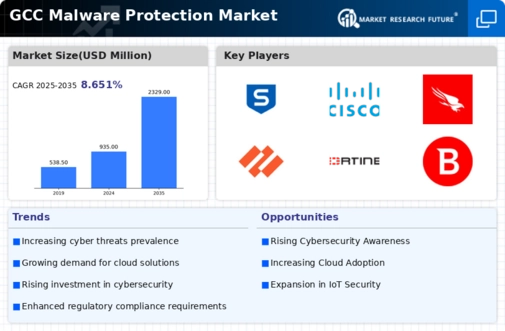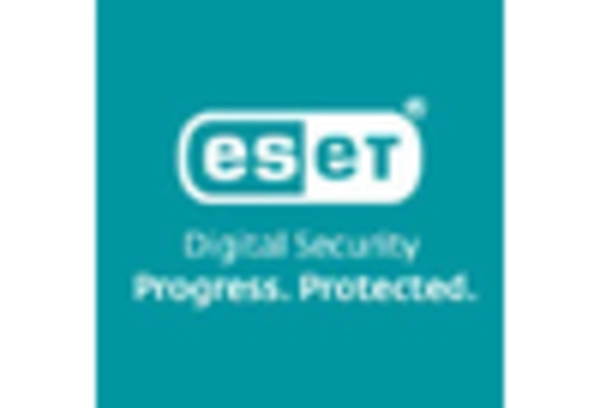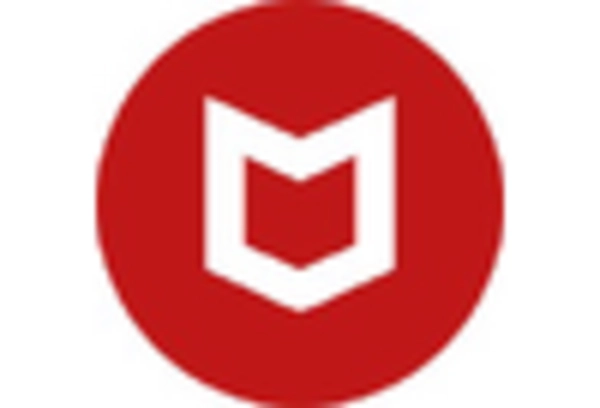Regulatory Pressures
The malware protection market is influenced by increasing regulatory pressures in the GCC, as governments implement stricter data protection laws and cybersecurity frameworks. Compliance with regulations such as the UAE's Data Protection Law and Saudi Arabia's Personal Data Protection Law is becoming essential for businesses operating in the region. Failure to comply can result in substantial fines and legal repercussions, prompting organizations to prioritize malware protection solutions. In 2025, it is anticipated that compliance-related expenditures will account for approximately 20% of IT budgets in the GCC. This trend indicates a growing recognition of the importance of cybersecurity and data protection, driving investments in malware protection technologies to ensure adherence to regulatory requirements.
Rising Cyber Threats
The malware protection market is experiencing growth due to the increasing frequency and sophistication of cyber threats in the GCC region. Organizations are facing a surge in ransomware attacks, phishing schemes, and other malicious activities that compromise sensitive data. In 2025, it is estimated that cybercrime costs could reach $10 trillion globally, with a significant portion attributed to the GCC. This alarming trend compels businesses to invest in robust malware protection solutions to safeguard their digital assets. As a result, the demand for advanced security measures is likely to escalate, driving the malware protection market forward. Companies are prioritizing cybersecurity budgets, with many allocating up to 15% of their IT expenditures to malware protection solutions, indicating a strong commitment to enhancing their defenses against evolving threats.
Increased Digital Transformation
The ongoing digital transformation across various sectors in the GCC is a key driver for the malware protection market. As organizations adopt cloud computing, IoT devices, and mobile technologies, the attack surface for cybercriminals expands. This transformation necessitates the implementation of comprehensive malware protection strategies to mitigate risks associated with new technologies. In 2025, the GCC's digital economy is projected to contribute $100 billion to the region's GDP, underscoring the importance of securing digital infrastructures. Consequently, businesses are increasingly recognizing the need for effective malware protection solutions to ensure operational continuity and protect customer data. The integration of security measures into digital transformation initiatives is becoming a priority, further propelling the growth of the malware protection market.
Emergence of Advanced Technologies
The emergence of advanced technologies, such as artificial intelligence and machine learning, is reshaping the malware protection market in the GCC. These technologies enable organizations to enhance their threat detection and response capabilities, allowing for more proactive security measures. In 2025, it is projected that AI-driven security solutions will account for over 30% of the malware protection market, reflecting a shift towards more sophisticated defense mechanisms. As businesses seek to leverage these technologies, they are likely to invest in solutions that offer real-time threat intelligence and automated responses. This trend not only improves the effectiveness of malware protection strategies but also positions organizations to stay ahead of evolving cyber threats, thereby driving growth in the malware protection market.
Growing Awareness of Cybersecurity
There is a notable increase in awareness regarding cybersecurity among businesses and consumers in the GCC, which is positively impacting the malware protection market. Organizations are beginning to understand the potential repercussions of cyber incidents, including financial losses and reputational damage. Surveys indicate that over 70% of businesses in the region now prioritize cybersecurity training for employees, reflecting a cultural shift towards proactive security measures. This heightened awareness is driving demand for malware protection solutions, as companies seek to educate their workforce and implement effective security protocols. The malware protection market is likely to benefit from this trend, as organizations invest in comprehensive training programs and advanced security technologies to combat the rising tide of cyber threats.

















Leave a Comment